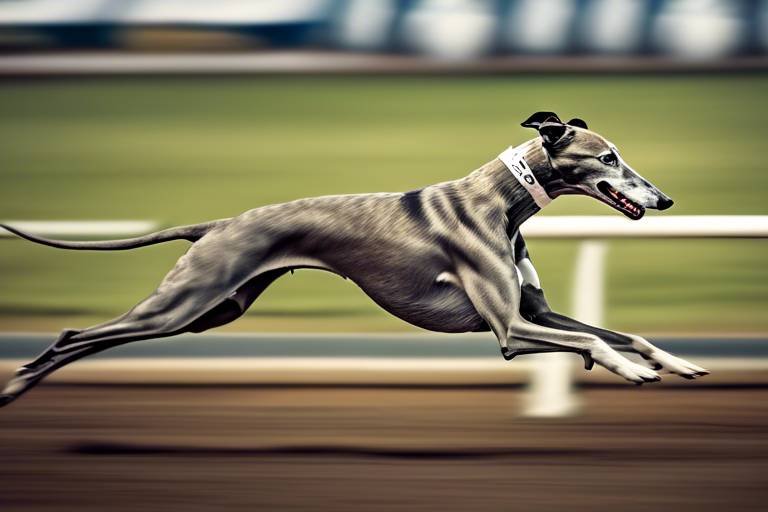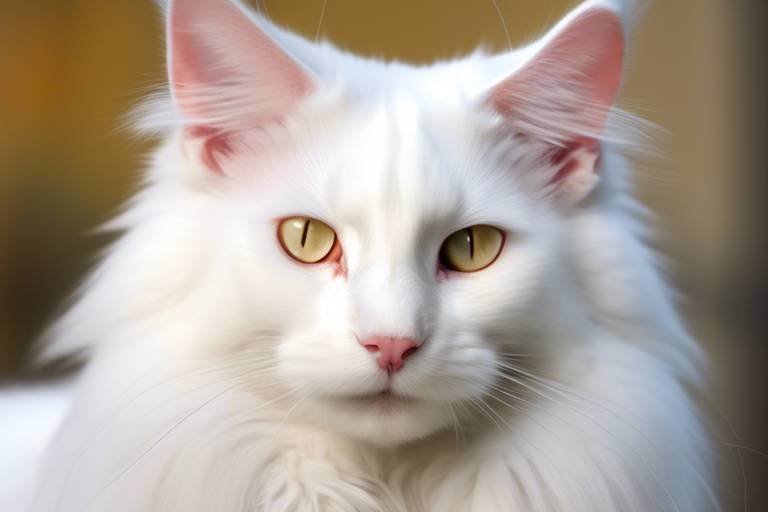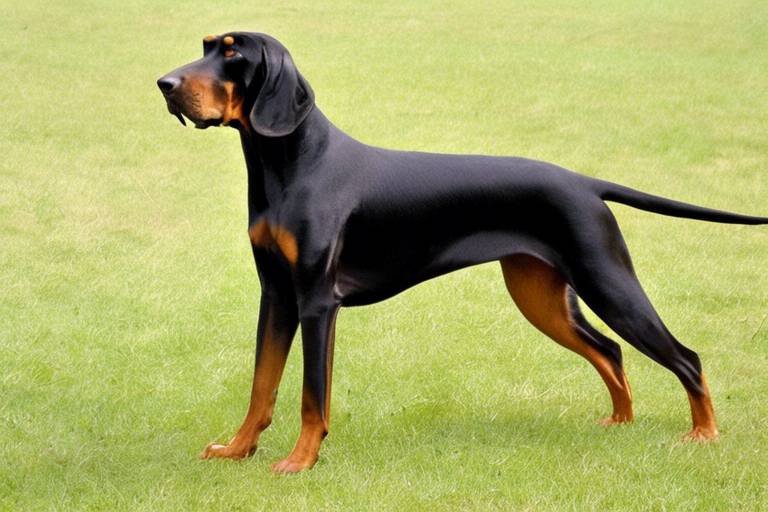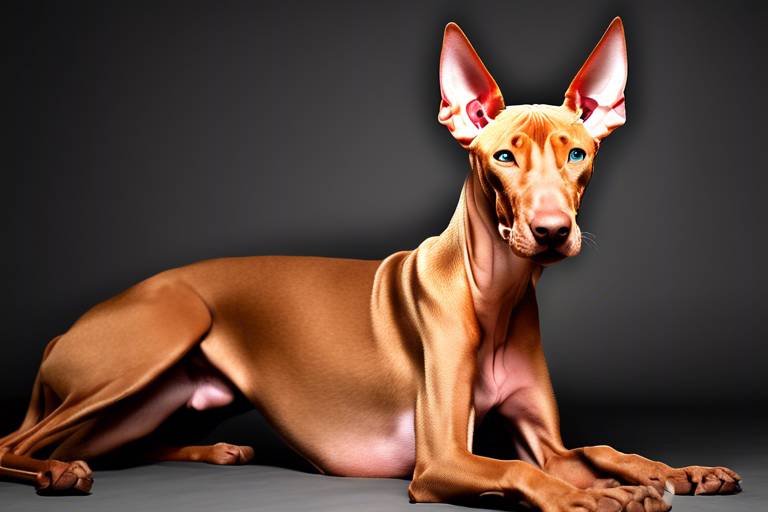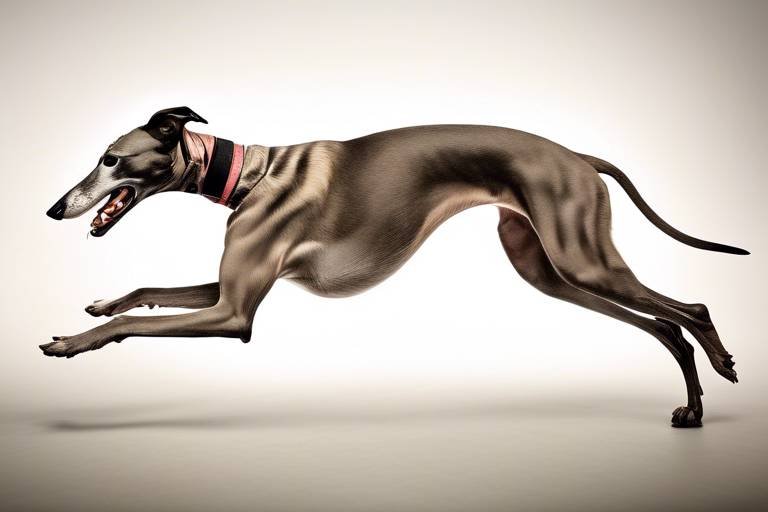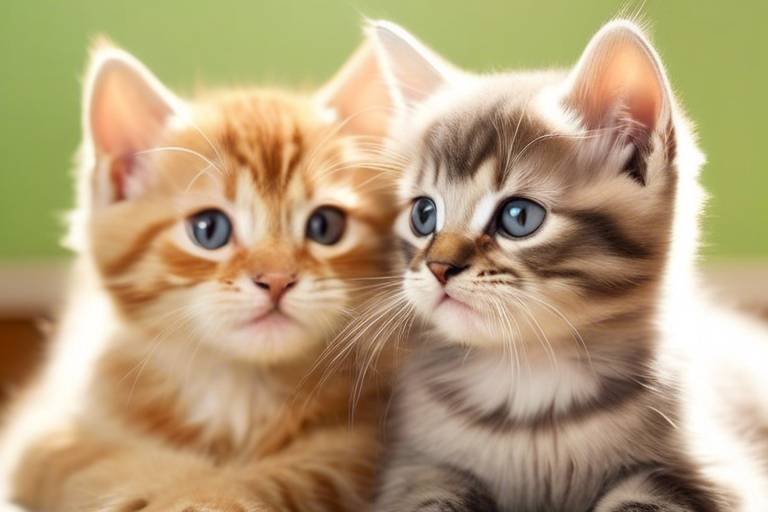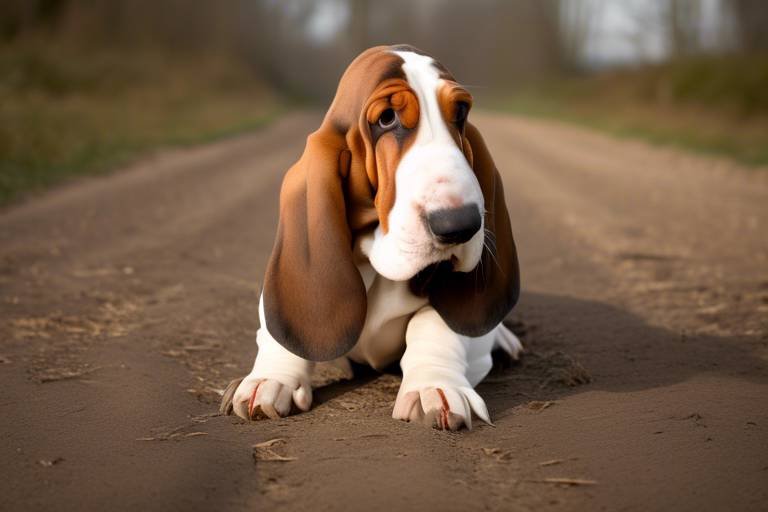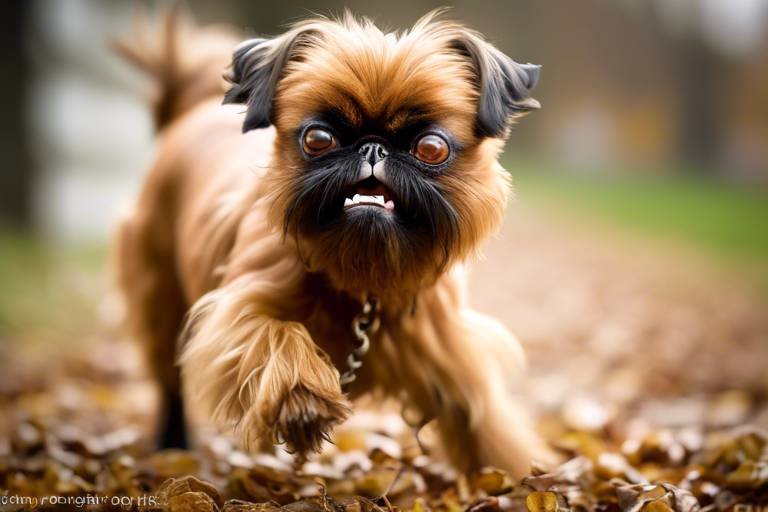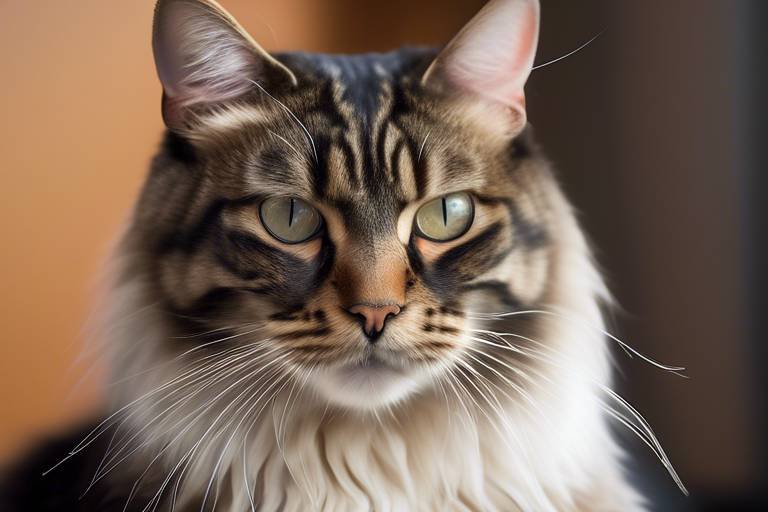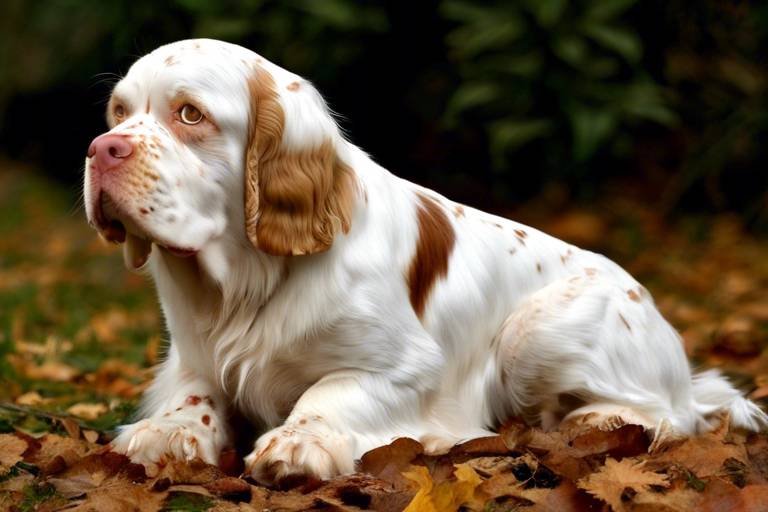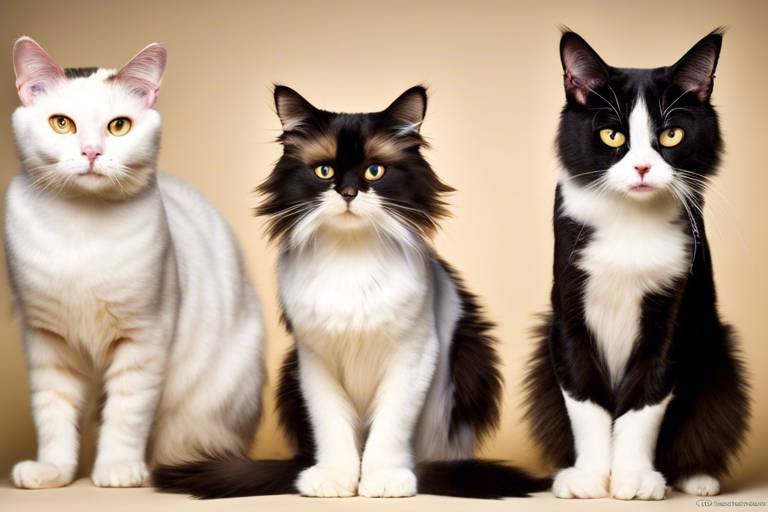The Characteristics of the Greyhound - Speed and Grace
When you think of the Greyhound, what comes to mind? Perhaps it's their astonishing speed, or the way they glide gracefully across the ground like a sleek arrow. These magnificent dogs are not just fast; they embody a unique combination of elegance, strength, and a gentle spirit that makes them truly special. In this article, we will explore the remarkable traits of Greyhounds, from their fascinating history to their physical characteristics, temperament, and care needs. Whether you're considering adopting one or simply want to learn more about this incredible breed, you're in for a treat!
The lineage of the Greyhound stretches back thousands of years, with origins tracing back to ancient Egypt. Imagine a time when these dogs were revered as symbols of royalty and grace, often depicted in hieroglyphics alongside pharaohs. Greyhounds were bred for their exceptional speed, primarily for hunting game. Over the centuries, they evolved alongside humans, becoming not only skilled hunters but also beloved companions. Their historical significance is profound, as they have been cherished by various cultures, from the Egyptians to the Romans, who valued them for their agility and loyalty.
Greyhounds are renowned for their sleek, aerodynamic bodies that contribute to their incredible speed and agility. Their unique physical traits make them one of the fastest dog breeds in the world. With a distinct build that includes long legs, a deep chest, and a narrow waist, Greyhounds are perfectly designed for sprinting. Let's break down their physical characteristics further:
Typically, Greyhounds stand between 24 to 30 inches tall and weigh between 60 to 70 pounds. This size range not only impacts their speed but also plays a role in their overall health. A well-proportioned Greyhound is a sight to behold, and their size allows them to cover ground quickly. However, it's essential for owners to be mindful of their weight, as obesity can lead to various health issues.
One of the delightful aspects of Greyhounds is their variety of coat colors. They come in shades such as brindle, fawn, black, and even blue. This diversity adds to their charm, making each Greyhound unique. Some may have distinctive markings or patterns, further enhancing their individuality. Regardless of their color, one thing is certain: Greyhounds are stunning dogs that draw attention wherever they go.
The Greyhound's long legs and deep chest are essential for speed. Their body structure is a marvel of evolution, allowing them to reach speeds of up to 45 miles per hour in short bursts. This incredible capability is due to their powerful muscles and flexible spine, which work together to propel them forward. Just like a finely tuned sports car, every aspect of their anatomy is designed for performance, making them one of nature's most efficient runners.
Despite their racing prowess, Greyhounds are known for their gentle and friendly nature. They are often described as "couch potatoes" when they're not running, enjoying long naps and lounging around the house. Their calm demeanor makes them excellent companions, especially for families and individuals looking for a loving pet. Greyhounds are generally good with children and can get along well with other pets, provided they are socialized properly from a young age.
While Greyhounds are incredibly fast, they require only moderate exercise. A couple of short walks each day and some playtime in a secure yard are usually sufficient to keep them happy and healthy. However, it's essential to engage them in activities that stimulate their minds as well. Training a Greyhound can be a rewarding experience, but it does come with its challenges due to their independent nature. Understanding their unique personality is key to successful training.
Proper socialization is crucial for Greyhounds to become well-adjusted pets. Exposing them to various environments, people, and other animals can help them develop confidence and reduce anxiety. Consider enrolling them in puppy classes or arranging playdates with other dogs. The more experiences they have, the better they will adapt to different situations.
Training a Greyhound can present challenges, particularly because of their independent streak. They may not always respond to commands as quickly as other breeds. However, with patience and consistency, you can overcome these hurdles. Positive reinforcement techniques, such as treats and praise, work wonders in motivating them. Remember, every Greyhound is unique, so tailor your approach to suit their personality.
Like all breeds, Greyhounds are prone to specific health issues. Regular veterinary check-ups are essential for monitoring their health and catching any potential problems early. Common health concerns include hip dysplasia, bloat, and certain heart conditions. Being proactive about their health care can help ensure your Greyhound lives a long, happy life.
A balanced diet is vital for a Greyhound's health. Providing high-quality dog food that meets their nutritional requirements is essential. It's also important to monitor their weight and adjust their diet as necessary to prevent obesity. Consult with your veterinarian to determine the best feeding practices for your furry friend.
Routine vet visits are essential for monitoring health. Regular check-ups and vaccinations can catch potential issues before they become serious. Greyhounds may have specific health needs, so keeping an open line of communication with your vet is crucial.
- Are Greyhounds good family pets? Yes, they are known for their gentle nature and can be great companions for families.
- How much exercise do Greyhounds need? They require moderate exercise, such as a couple of short walks and playtime each day.
- Do Greyhounds get along with other pets? With proper socialization, Greyhounds can get along well with other pets.
- What health issues are common in Greyhounds? They can be prone to hip dysplasia, bloat, and certain heart conditions.
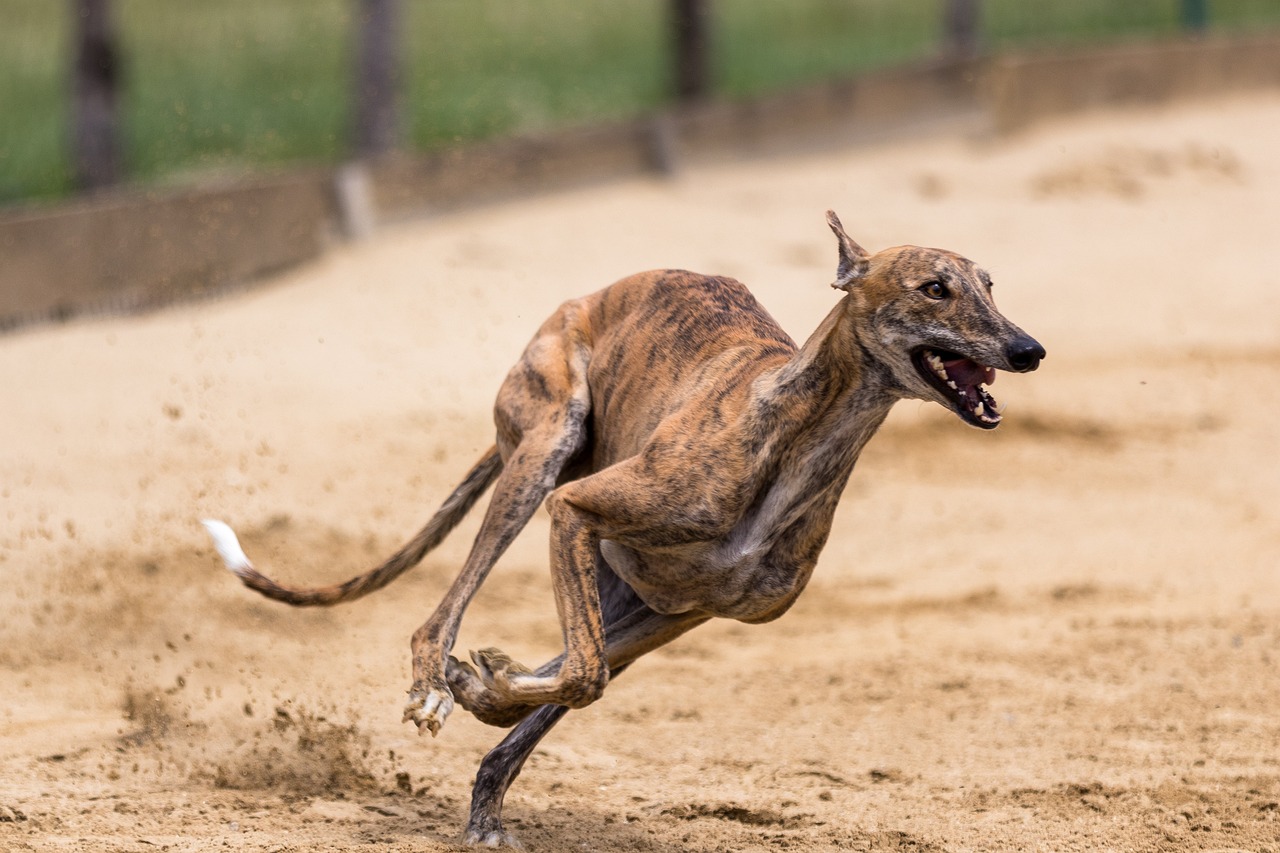
History of the Greyhound
The Greyhound is a breed that boasts a lineage stretching back thousands of years, with its roots deeply embedded in the sands of ancient Egypt. These elegant dogs were not just companions; they were revered for their speed and hunting prowess. In fact, historical records and artifacts suggest that Greyhounds were often depicted in ancient Egyptian hieroglyphs, showcasing their importance in the lives of the pharaohs.
As time progressed, Greyhounds made their way across continents. They were brought to Europe via trade routes and became popular among the nobility. The breed was even mentioned in legal texts, where laws dictated who could own such a noble animal, often restricting it to the upper classes. This exclusivity further cemented the Greyhound's status as a symbol of grace and speed.
In medieval England, Greyhounds were used for hunting deer and hares, showcasing their incredible agility and speed. The breed's unique ability to run at astonishing speeds made them the preferred choice for hunters. Interestingly, this led to the development of various hunting techniques that highlighted their natural instincts. The phrase “to go to the dogs” even originates from the era when Greyhounds were seen as the ultimate hunting companions.
Throughout the centuries, Greyhounds have undergone various changes, adapting to different environments and needs. In the 19th century, the advent of dog racing brought a new wave of popularity to the breed. Tracks were built specifically for Greyhound racing, and these dogs became stars in their own right, drawing crowds eager to witness their breathtaking speed. The racing industry has played a significant role in shaping the modern Greyhound, leading to the establishment of breed standards that emphasize their physical characteristics.
Today, while many Greyhounds still participate in racing, a growing number are being adopted as pets. This shift has brought attention to the breed's gentle and affectionate nature, contrasting sharply with their image as racing athletes. Greyhounds are now often seen lounging on couches, enjoying a relaxed lifestyle after their racing days are over. This evolution from racing dogs to beloved family pets highlights the adaptability and resilience of the breed.
In summary, the history of the Greyhound is a fascinating journey through time, showcasing their significance in ancient cultures, their role in hunting, and their transformation into cherished companions. As we continue to appreciate these remarkable dogs, it’s essential to recognize their rich heritage and the unique qualities that make them stand out in the canine world.
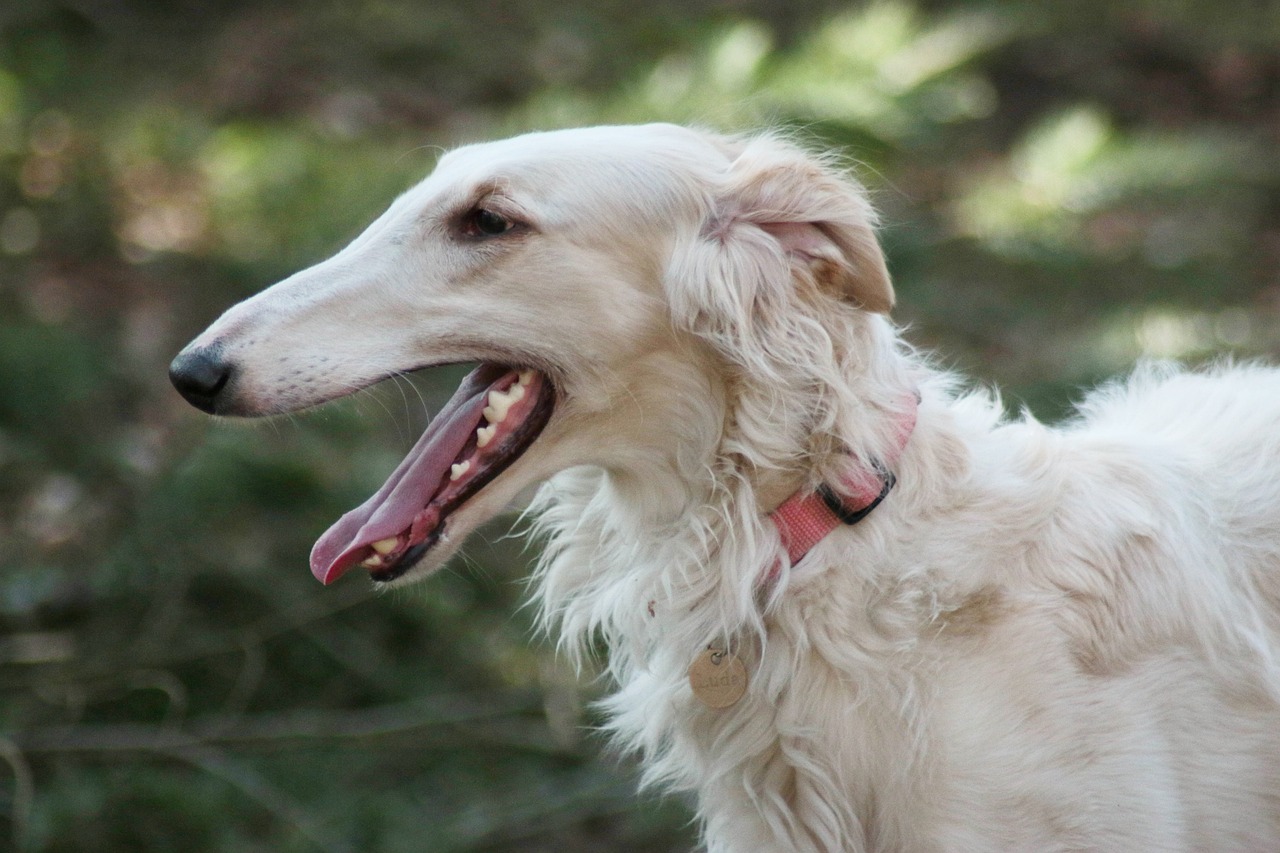
Physical Characteristics
When you think of a Greyhound, the first thing that probably comes to mind is their sleek and elegant appearance. These dogs are the epitome of speed and grace, boasting a body structure that is uniquely designed for racing. Their aerodynamic shape allows them to slice through the air with minimal resistance, making them one of the fastest dog breeds in the world. But there's more to them than just speed; their physical characteristics tell a fascinating story about their evolution and purpose.
Typically, Greyhounds stand between 24 to 30 inches tall at the shoulder and weigh around 60 to 70 pounds. This size range is optimal for their athletic abilities, allowing them to maintain a balance between strength and agility. The taller and leaner structure contributes to their ability to reach remarkable speeds, often clocking in at over 40 miles per hour during races. However, their size also plays a crucial role in their overall health. A well-proportioned Greyhound is less likely to suffer from joint issues and other health complications, making it essential for owners to monitor their weight and ensure they remain within this healthy range.
One of the most delightful aspects of Greyhounds is their variety of coat colors. You'll find them in shades ranging from brindle, fawn, and black to more unique combinations like blue and white. This diversity adds to their charm and appeal, and each color has its own unique beauty. The coat itself is short and smooth, requiring minimal grooming, which is a bonus for busy pet owners. The glossy finish of their coats, coupled with their elegant posture, makes Greyhounds truly stand out in any crowd.
The Greyhound's body structure is a marvel of nature, specifically designed for speed. Their long legs provide the leverage needed to cover ground quickly, while their deep chest houses powerful lungs that supply the oxygen necessary for sprinting. This combination of features creates a powerful engine that allows them to maintain high speeds over short distances. Additionally, their flexible spine aids in their running style, allowing for a long, graceful stride. When you see a Greyhound in motion, it's like watching a finely tuned machine at work—every part of their body working in harmony to achieve incredible speed.
In summary, the physical characteristics of Greyhounds are not just for show; they are essential for their functionality as a breed. From their size and weight to their distinctive coat colors and unique body structure, every trait contributes to what makes them exceptional athletes and beloved companions.
- What is the average lifespan of a Greyhound? Greyhounds typically live between 10 to 14 years, depending on their health and care.
- Are Greyhounds good with children? Yes, Greyhounds are generally gentle and friendly, making them great companions for children.
- Do Greyhounds require a lot of exercise? While they are fast runners, Greyhounds require moderate exercise and enjoy lounging around the house.
- Are Greyhounds prone to any specific health issues? Yes, they can be prone to certain health issues such as bloat and hip dysplasia, so regular vet check-ups are important.
Size and Weight
The size and weight of a Greyhound are significant factors that contribute to their overall capabilities and health. Typically, these graceful canines stand between 24 to 30 inches tall at the shoulder and weigh between 60 to 70 pounds. This impressive height gives them a commanding presence, while their weight is perfectly balanced for speed and agility. The combination of their tall stature and lean build allows Greyhounds to reach astonishing speeds, often clocking in at around 45 miles per hour during a race. It's like watching a sleek sports car zoom by—effortless, yet powerful!
When considering the size and weight of a Greyhound, it’s essential to understand how these factors impact their overall health and lifestyle. A larger Greyhound may require more space to run and play, while a smaller one might be more suited for apartment living. However, regardless of size, all Greyhounds need ample room to stretch their legs, as they are built for speed rather than endurance. Their body structure is designed for quick bursts of energy, much like a sprinter, rather than long-distance running.
To give you a clearer picture, here’s a quick breakdown of their size and weight:
| Height (inches) | Weight (pounds) |
|---|---|
| 24 - 26 | 60 - 65 |
| 27 - 29 | 65 - 70 |
| 30+ | 70+ |
It's also important to note that, like humans, Greyhounds can come in various shapes and sizes. Some may be a bit stockier, while others might be more slender. This variation can affect their health, so regular veterinary check-ups are crucial to monitor their weight and ensure they remain within a healthy range. Maintaining an ideal weight not only supports their athleticism but also contributes to their longevity and quality of life.
In summary, understanding the size and weight of Greyhounds is key to providing them with the right environment and care. Whether you’re considering adopting one or simply fascinated by these incredible dogs, their physical attributes are just one part of what makes them so special. Their size may be impressive, but it’s their speed and grace that truly captivate the hearts of dog lovers everywhere.
Coat Colors
When it comes to Greyhounds, their beauty is not just in their speed and grace but also in their stunning coat colors. These dogs come in a delightful array of colors and patterns, each adding to their unique charm. You might be surprised to learn that Greyhounds can be found in the following colors:
- Brindle: This striking pattern features a mix of fawn and black stripes, giving the Greyhound a tiger-like appearance.
- Fawn: A warm, golden hue that radiates elegance and is one of the most recognizable colors in the breed.
- Black: Sleek and classic, black Greyhounds exude a sense of mystery and sophistication.
- Blue: A rare variation, blue Greyhounds have a beautiful slate-gray coat that stands out in a crowd.
- White: Often with patches of color, white Greyhounds are striking and eye-catching.
- Red: This vibrant color adds a touch of warmth and energy to the Greyhound's appearance.
Each coat color not only enhances the Greyhound's appearance but also reflects their lineage and genetics. Interestingly, coat colors can sometimes influence the dog's personality and temperament, although this is not a hard and fast rule. For instance, brindle Greyhounds are often described as playful and energetic, while black Greyhounds may be perceived as more reserved and calm.
Moreover, the coat color can also have practical implications. For example, lighter-colored Greyhounds may be more susceptible to sunburn, especially in areas with high UV exposure. Therefore, owners of lighter-colored Greyhounds should be mindful of sun protection, ensuring their furry friends have access to shaded areas during outdoor activities.
In conclusion, the coat colors of Greyhounds are more than just a visual feature; they contribute to the breed's identity and can even affect their care needs. Whether you are drawn to the elegance of a fawn Greyhound or the striking appearance of a brindle, each color tells a story of its own. So, when considering adopting a Greyhound, think about the coat color that resonates with you and your lifestyle!
Q: Do Greyhounds shed a lot?
A: Greyhounds have short coats and are considered low shedders. Regular brushing helps keep their coats healthy and reduces shedding.
Q: Are certain coat colors more prone to health issues?
A: Generally, coat color does not directly correlate with health issues. However, lighter colors may require additional sun protection.
Q: Can Greyhounds have mixed coat colors?
A: Yes, many Greyhounds can have a combination of colors or patterns, making each dog unique.
Body Structure
When you look at a Greyhound, the first thing that strikes you is their elegant body structure. These dogs are built for speed, and their physical attributes reflect that incredible design. With long, slender legs that seem to stretch for miles, Greyhounds can achieve astonishing speeds, often reaching up to 45 miles per hour! It's almost as if they were crafted by nature for the sole purpose of running. Their deep chest allows for ample lung capacity, which is crucial for sustaining that breathtaking pace.
Their narrow waist and long neck contribute to an aerodynamic shape that minimizes wind resistance. Imagine a sports car, streamlined and ready to zoom down the highway—that’s what a Greyhound embodies when they take off running. This unique body structure not only aids in their speed but also provides them with remarkable agility, allowing them to navigate turns and obstacles with ease.
Let’s break down some of the key components of their body structure:
- Legs: Long and powerful, Greyhound legs are muscular and designed for sprinting. Their unique anatomy gives them a powerful stride.
- Chest: A deep and broad chest allows for efficient breathing during high-speed chases. It’s like having a high-performance engine that can take in plenty of air.
- Feet: Their feet are compact and equipped with strong pads, which provide excellent traction and support, much like the tires of a race car gripping the track.
Additionally, the Greyhound's skin is thin and tight, which helps reduce drag while running. This means that they can cover ground quickly without the burden of excess weight. Their body is not just about speed; it’s also about grace. When a Greyhound moves, it’s as if they’re gliding across the ground, showcasing a fluid motion that is both captivating and mesmerizing.
In essence, the body structure of a Greyhound is a perfect marriage of form and function. Every feature, from their long legs to their deep chest, plays a vital role in their ability to run swiftly and gracefully. This combination not only makes them exceptional athletes but also gives them a unique charm that many dog lovers appreciate.
- What is the average lifespan of a Greyhound? Greyhounds typically live between 10 to 14 years, depending on their health and care.
- Do Greyhounds require a lot of exercise? While they are known for their speed, Greyhounds only need moderate exercise, such as daily walks and occasional sprinting.
- Are Greyhounds good with children? Yes, Greyhounds are generally gentle and friendly, making them suitable companions for families with children.
- What are common health issues in Greyhounds? Some common health concerns include bloat, hip dysplasia, and certain heart conditions. Regular veterinary check-ups are essential.
Temperament and Behavior
When it comes to the temperament of Greyhounds, one word comes to mind: gentle. These dogs are often described as affectionate and friendly, making them fantastic companions for families and individuals alike. Despite their impressive speed and athleticism, Greyhounds possess a surprisingly calm demeanor. They are not the hyperactive type; instead, they are more like the cool kids in school who know they’re fast but prefer to lounge around most of the day. This unique combination of energy and tranquility makes them suitable for a variety of living situations, including apartments.
Greyhounds are known to be social animals that thrive on human interaction. They are often referred to as couch potatoes because they love to relax and snuggle with their owners. However, don’t let their laid-back nature fool you; they still require regular social engagement. This breed is generally well-mannered, but they can be a bit shy or reserved around strangers. Proper socialization from a young age is crucial to help them develop confidence and ensure they are comfortable in various environments.
Interestingly, Greyhounds have a unique way of communicating. They may not bark as much as other breeds, but they express themselves through a range of body language cues. For instance, a wagging tail usually indicates happiness, while a lowered head might suggest insecurity. Understanding these signals can significantly enhance the bond between you and your Greyhound. It’s essential to pay attention to their moods and feelings, as this will help you provide the best care possible.
Moreover, Greyhounds are typically good with children and other pets, especially if they are raised together. However, it’s important to monitor interactions, particularly with smaller animals, as their prey drive can sometimes kick in. This instinct is a remnant from their racing days, where chasing was a part of their daily routine. To mitigate this, early socialization and training can help them learn how to interact appropriately with other pets.
In summary, Greyhounds are a unique blend of speed and grace, coupled with a gentle temperament. They are affectionate, calm, and social creatures that make wonderful companions. Their ability to adapt to different living situations, combined with their friendly nature, makes them an excellent choice for many households. Just remember, like all dogs, they thrive on love, attention, and understanding.
- Are Greyhounds good family pets? Yes, Greyhounds are known for their gentle and friendly nature, making them great companions for families.
- Do Greyhounds need a lot of exercise? While they are fast, Greyhounds require moderate exercise. Regular walks and playtime are essential for their well-being.
- Can Greyhounds live in apartments? Absolutely! Their calm demeanor makes them well-suited for apartment living, provided they get regular exercise.
- How do I socialize my Greyhound? Start by exposing them to various environments, people, and other pets. Positive reinforcement can help them feel more comfortable.
- Are Greyhounds prone to any health issues? Like all breeds, Greyhounds can be prone to certain health issues. Regular vet check-ups and a balanced diet are crucial for their health.
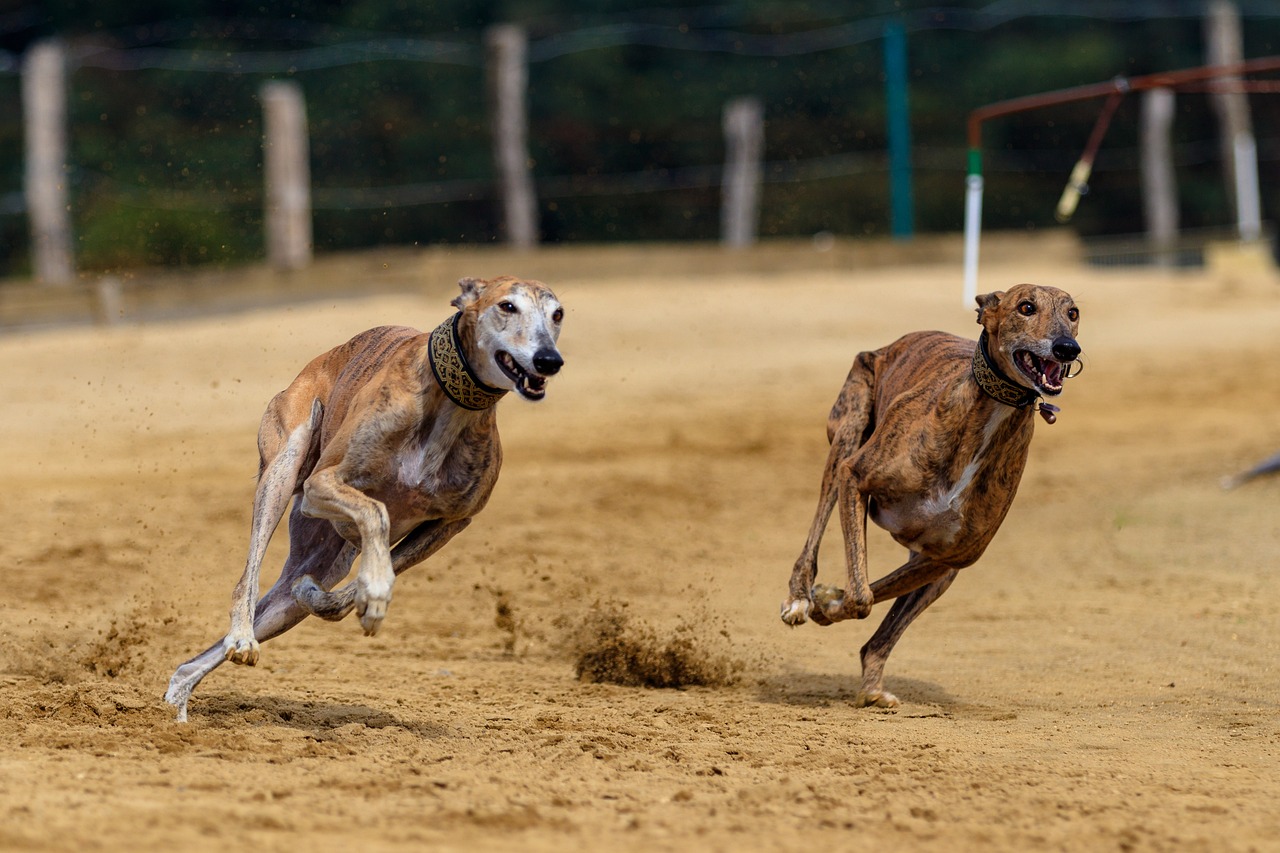
Training and Exercise Needs
When it comes to training and exercise, Greyhounds are a fascinating mix of speed and laid-back charm. You might think that these sleek athletes require hours of rigorous workouts to maintain their impressive physique, but surprisingly, they are not as demanding as one might expect. In fact, a Greyhound's exercise needs are quite moderate compared to other breeds. They thrive on short bursts of activity, which makes them perfect companions for those who enjoy a leisurely lifestyle but still want to engage in some playtime.
Regular walks are essential for a Greyhound's physical and mental well-being. A daily routine of 30 to 60 minutes of walking or light jogging is usually sufficient to keep them fit and happy. However, it’s crucial to note that Greyhounds are sprinters by nature. They love to run, and when they do, they can reach speeds of up to 45 miles per hour in a matter of seconds! Therefore, if you have access to a secure, fenced area, allowing your Greyhound to sprint occasionally can be incredibly beneficial. Just imagine them racing like the wind, their long legs propelling them forward with grace and ease.
Training a Greyhound can be a rewarding experience, but it comes with its own set of challenges. These dogs are known for their independent streak, which can sometimes make them seem aloof or disinterested in commands. Therefore, using positive reinforcement techniques, such as treats and praise, can work wonders. They respond best to a gentle approach, so patience is key. Establishing a routine and keeping training sessions short and engaging will help maintain their focus. After all, who wouldn’t want to earn a tasty reward for a job well done?
Socialization is another critical aspect of a Greyhound's training. Early exposure to different environments, people, and other animals can help them become well-adjusted adults. Consider taking your Greyhound to parks, pet-friendly events, or even on road trips to broaden their horizons. The more experiences they have, the more confident they will become in various situations. Remember, a well-socialized Greyhound is a happy Greyhound!
| Training Tips | Description |
|---|---|
| Positive Reinforcement | Use treats and praise to encourage desired behaviors. |
| Short Sessions | Keep training sessions brief to maintain their interest. |
| Routine | Establish a consistent training routine for better results. |
| Socialization | Expose them to various environments and other pets. |
In conclusion, while Greyhounds may be known for their incredible speed, their training and exercise needs are quite manageable. With a little patience, positive reinforcement, and regular exercise, you can ensure that your Greyhound stays healthy and happy. So, whether you're taking them for a leisurely stroll or watching them sprint across a field, you're in for an exhilarating experience with these remarkable dogs!
- How much exercise does a Greyhound need daily? Greyhounds typically require about 30 to 60 minutes of exercise each day, including walks and playtime.
- Are Greyhounds easy to train? While they can be independent, Greyhounds respond well to positive reinforcement and consistent training methods.
- Can Greyhounds live in apartments? Yes, Greyhounds can adapt well to apartment living as long as they receive regular exercise.
- Do Greyhounds need a lot of grooming? No, Greyhounds have short coats that require minimal grooming, making them low-maintenance in that regard.
Socialization Techniques
Socializing a Greyhound is not just a good idea; it's essential for their overall well-being. These dogs, despite their gentle demeanor, can be quite sensitive and may not always know how to interact with other animals or people. Think of socialization as a crucial training ground where your Greyhound learns the ropes of the world around them. The earlier you start, the better, but it's never too late to introduce them to new experiences!
One effective technique is to expose your Greyhound to a variety of environments. This can include bustling parks, busy streets, and even quiet neighborhoods. Each new place introduces different sounds, smells, and sights, which can help your Greyhound become more adaptable and confident. For instance, if you take them to a dog park, they’ll encounter other dogs and people, allowing them to learn appropriate behaviors. However, always supervise these interactions to ensure safety.
Another important aspect of socialization is meeting different people. Invite friends over or take your Greyhound to pet-friendly events. This exposure helps them become comfortable around strangers, reducing anxiety in unfamiliar situations. When introducing your Greyhound to new people, use treats and praise to create positive associations. You might say, “Look, that’s a friend! Isn’t he nice?” while giving your dog a treat, reinforcing the idea that new people are not to be feared but embraced.
Additionally, consider enrolling your Greyhound in training classes. These classes not only teach basic commands but also provide a structured environment for socialization. Your dog will interact with other dogs and people under the guidance of a trainer, which can be incredibly beneficial. It's like a mini boot camp for social skills!
Here are a few key points to remember when socializing your Greyhound:
- Start early: The sooner, the better.
- Be patient: Socialization is a gradual process.
- Use positive reinforcement: Treats and praise go a long way.
- Monitor interactions: Always keep an eye on your dog during playtime.
- Be consistent: Regular exposure is key to successful socialization.
In summary, socializing your Greyhound is a vital part of their development. By exposing them to various environments, people, and situations, you help them grow into well-adjusted companions. Remember, the goal is to create positive experiences, so keep it fun and engaging!
- How early should I start socializing my Greyhound?
It's best to start as early as possible, ideally when they are puppies. However, older dogs can still benefit from socialization. - What if my Greyhound is fearful of other dogs?
Take it slow. Introduce them to calm and friendly dogs first, and use treats to create positive associations. - Are there specific places I should avoid?
Avoid overly chaotic environments initially. Gradually introduce your Greyhound to busier places as they become more comfortable. - Can I socialize my Greyhound alone?
While it is possible, having a friend or trainer can provide additional support and guidance.
Common Training Challenges
Training a Greyhound can be a rewarding yet challenging experience. These magnificent dogs, with their sleek bodies and gentle demeanor, often come with a unique set of hurdles that owners must navigate. One of the primary challenges is their independent nature. Unlike some breeds that thrive on obedience and eager-to-please behavior, Greyhounds can sometimes seem aloof or uninterested in following commands. This independence can lead to moments of frustration for owners who expect a more compliant response.
Another common issue is their high prey drive. Greyhounds were bred for speed and hunting, which means they have a strong instinct to chase after small animals. This instinct can complicate training sessions, especially if they spot a squirrel or a cat during a walk. Owners must be vigilant and proactive, employing techniques that redirect this prey drive into positive behaviors. For instance, using toys or treats to capture their attention can be an effective strategy.
Furthermore, Greyhounds are known for their sensitivity. Harsh training methods can be counterproductive, as these dogs respond better to positive reinforcement. This means that using treats, praise, and playtime as rewards can significantly enhance their learning experience. However, this approach requires patience and consistency, as Greyhounds may take longer to grasp certain commands compared to more eager breeds.
It’s also essential to consider their exercise needs. While Greyhounds don’t require as much exercise as one might think, they do need regular bursts of activity to keep them mentally stimulated. A lack of physical activity can lead to boredom, which may manifest in undesirable behaviors. Incorporating short, fun training sessions into their daily routine can help keep their minds sharp and engaged.
Lastly, socialization is a crucial aspect of training that can present its own challenges. Greyhounds may not always be naturally inclined to interact with other dogs or people due to their past as racing dogs. Therefore, early and ongoing socialization is essential. This can be achieved through controlled introductions to various environments, people, and other pets. The goal is to help them become well-adjusted and confident companions.
In summary, while training a Greyhound can come with its set of challenges, understanding these hurdles is the first step towards overcoming them. By employing positive reinforcement, being patient, and ensuring they receive adequate exercise and socialization, owners can help their Greyhounds thrive. Remember, every dog is unique, so what works for one may not work for another. Stay flexible, and most importantly, enjoy the journey of training your graceful companion!
- What is the best method for training a Greyhound? Positive reinforcement is the most effective method for training Greyhounds. Use treats, praise, and play to encourage desired behaviors.
- How much exercise do Greyhounds need? Greyhounds need moderate exercise, including short walks and playtime. They are sprinters, so quick bursts of activity are ideal.
- Are Greyhounds good with children? Yes, Greyhounds can be excellent companions for children, but supervision is always recommended to ensure safe interactions.
- How can I help my Greyhound with socialization? Gradually introduce your Greyhound to different environments, people, and other dogs to help them become well-adjusted.
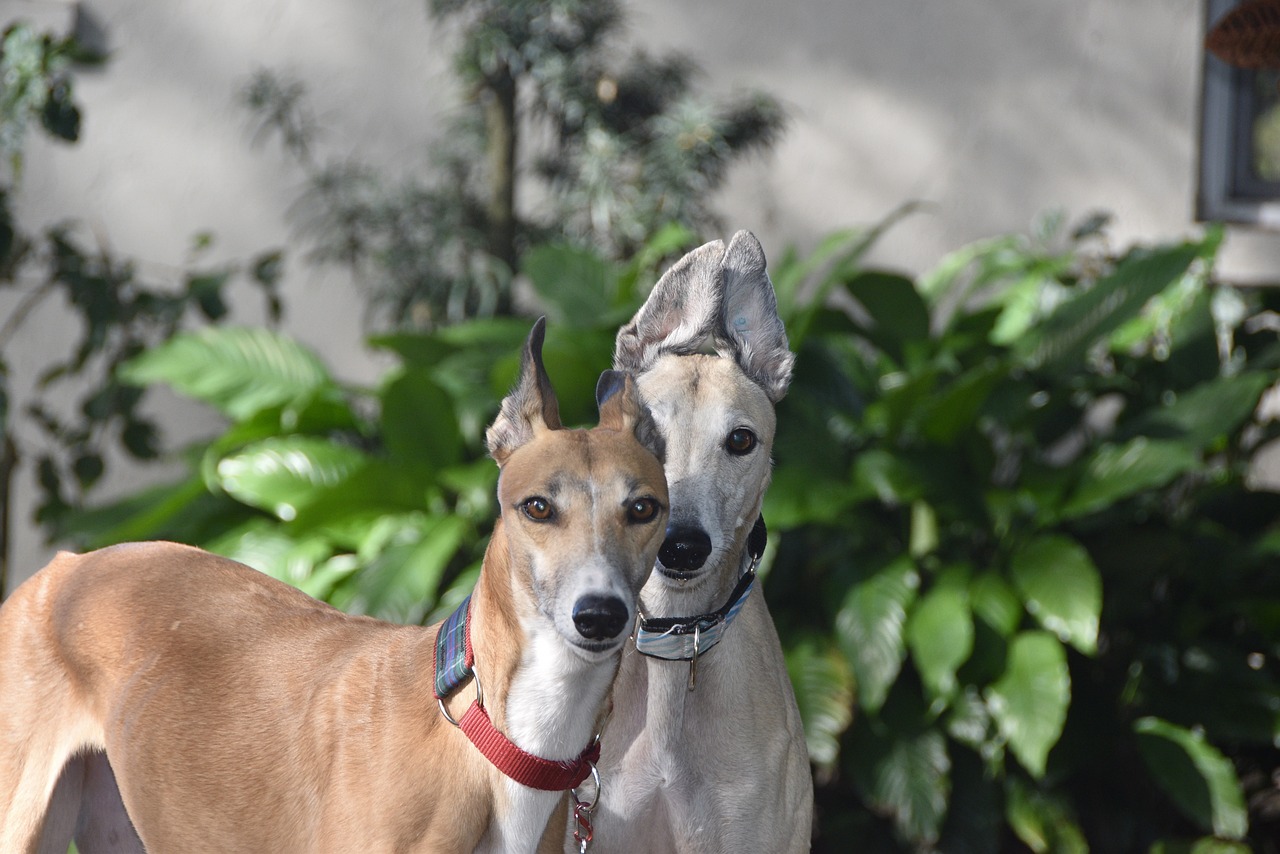
Health Considerations
When it comes to the health of your beloved Greyhound, understanding the breed's unique needs is paramount. Just like any athlete, Greyhounds have specific health considerations that require attention from their owners. These elegant creatures, while known for their speed and grace, are prone to certain health issues that can affect their quality of life. Regular check-ups and a proactive approach to their health can make all the difference.
One of the most common health concerns for Greyhounds is their susceptibility to certain genetic conditions. Conditions such as hip dysplasia, bloat, and heart problems can arise, particularly in older dogs. It's essential to be aware of these issues and to monitor your Greyhound for any signs of discomfort or abnormal behavior. Regular veterinary visits are crucial, as they allow for early detection and management of potential health problems.
Another significant aspect of Greyhound health is their dietary needs. These dogs have distinct nutritional requirements that differ from other breeds. A well-balanced diet rich in protein is essential for maintaining their muscle mass and overall health. It's advisable to consult with your veterinarian to determine the best feeding practices for your Greyhound, ensuring they receive the right nutrients to fuel their active lifestyle.
| Common Health Issues | Symptoms | Preventative Measures |
|---|---|---|
| Hip Dysplasia | Difficulty in movement, limping | Regular vet check-ups, maintaining a healthy weight |
| Bloat | Abdominal swelling, restlessness | Feeding smaller meals, avoiding vigorous exercise after eating |
| Heart Problems | Coughing, fatigue | Routine heart screenings, maintaining a healthy lifestyle |
In addition to these health issues, Greyhounds are also prone to certain skin conditions. Their short coat may make them more susceptible to sunburn and skin allergies. Therefore, it's crucial to provide them with adequate shelter and avoid overexposure to the sun. Regular grooming can help keep their skin healthy and can also be a bonding activity between you and your pet.
Lastly, ensuring your Greyhound receives regular veterinary care is vital for their overall health. Regular check-ups allow for the monitoring of their health status and the administration of necessary vaccinations. Your veterinarian can also provide guidance on dental care, which is often overlooked but essential for preventing periodontal disease.
- What is the average lifespan of a Greyhound? Greyhounds typically live between 10 to 14 years, depending on their health and care.
- Do Greyhounds require special diets? Yes, they need a balanced diet high in protein to support their athletic build.
- How often should I take my Greyhound to the vet? Regular check-ups are recommended at least once a year, but more frequent visits may be necessary as they age.
- Are Greyhounds prone to any specific diseases? Yes, they can be prone to conditions like hip dysplasia and heart problems, so monitoring their health is crucial.
Dietary Needs
When it comes to ensuring your Greyhound thrives, understanding their is paramount. These elegant creatures, built for speed and grace, require a balanced diet that supports their unique physiology. Unlike some breeds that can thrive on a variety of foods, Greyhounds have specific nutritional requirements that cater to their athletic nature and metabolism. Most Greyhounds benefit from a diet that is rich in high-quality protein, essential fatty acids, and a balance of carbohydrates. Think of it like fueling a high-performance sports car; you wouldn’t fill it with just any fuel, right? The same goes for your furry friend.
A typical Greyhound's diet should consist of the following components:
- High-quality protein: Look for dog foods that list meat as the first ingredient. Protein is crucial for muscle repair and overall health.
- Healthy fats: Omega-3 and Omega-6 fatty acids are essential for a shiny coat and healthy skin. Fish oil or flaxseed oil can be excellent additions.
- Complex carbohydrates: Foods like brown rice or sweet potatoes provide energy without causing spikes in blood sugar levels.
It's also important to note that Greyhounds have a unique digestive system. Their faster metabolism means they might require smaller, more frequent meals throughout the day instead of one or two large servings. This approach not only aids digestion but also helps maintain their energy levels, especially if they’re active. Moreover, hydration is crucial; always ensure your Greyhound has access to fresh water, especially after exercise.
To give you a better idea of what a balanced diet looks like for a Greyhound, here’s a simple sample diet plan:
| Meal | Ingredients |
|---|---|
| Breakfast | 2 cups of high-quality dry dog food (with meat as the first ingredient) mixed with a tablespoon of fish oil |
| Lunch | 1 cup of cooked brown rice mixed with lean chicken or turkey |
| Dinner | 2 cups of dry dog food with a tablespoon of flaxseed oil and a small serving of vegetables |
Lastly, while it may be tempting to share your meals with your Greyhound, be cautious. Certain human foods can be harmful to dogs. Foods like chocolate, grapes, and onions should always be avoided. It’s best to stick to dog-specific treats and snacks to keep your Greyhound healthy and happy.
In conclusion, providing your Greyhound with a well-rounded diet tailored to their needs is essential for their longevity and vitality. Just like an athlete needs the right nutrients to perform at their best, your Greyhound deserves the same care. So, invest time in understanding their dietary requirements, and you’ll be rewarded with a happy, healthy companion!
Q: How much should I feed my Greyhound?
A: The amount can vary based on their age, weight, and activity level, but generally, they should be fed between 2 to 4 cups of high-quality dog food daily, divided into two meals.
Q: Can Greyhounds eat raw food?
A: Some owners choose to feed their Greyhounds a raw diet, which can be beneficial. However, it's essential to do thorough research and consult with a veterinarian to ensure it's balanced.
Q: Are there any foods I should avoid?
A: Yes, avoid foods like chocolate, grapes, onions, and anything high in fat or sugar. Always check with your vet if you're unsure about a specific food.
Regular Veterinary Care
When it comes to ensuring the health and well-being of your Greyhound, is absolutely essential. Just like us humans, our furry friends require routine check-ups to catch any potential health issues before they become serious problems. Think of it as a regular tune-up for your car; you wouldn’t want to wait until the engine starts making strange noises to take it in for maintenance, right? Regular vet visits allow you to keep a close eye on your Greyhound's health and ensure they’re living their best life.
During these visits, your veterinarian will conduct a thorough examination, checking everything from their heart and lungs to their teeth and skin. This is a great opportunity to discuss any concerns you might have, whether it’s about their diet, behavior, or any unusual symptoms you've noticed. Greyhounds, despite their incredible speed and grace, can be prone to certain health issues, including hip dysplasia, bloat, and heart problems. Regular check-ups can help catch these conditions early, allowing for more effective treatment.
Furthermore, vaccinations are a crucial part of your Greyhound's healthcare routine. Keeping their vaccinations up to date protects them from various diseases that can compromise their health. Here’s a quick overview of some common vaccinations your Greyhound may need:
| Vaccine | Purpose | Frequency |
|---|---|---|
| Rabies | Protects against rabies virus | Every 1-3 years |
| DAPP | Protects against distemper, adenovirus, parvovirus, and parainfluenza | Annually |
| Bordetella | Protects against kennel cough | Every 6-12 months |
In addition to vaccinations, regular dental cleanings are important for Greyhounds. Their unique jaw structure can lead to dental issues if not properly maintained. Your vet might recommend professional cleanings or provide tips for at-home care to keep their pearly whites in top shape.
Another aspect of veterinary care is preventative treatments for parasites such as fleas, ticks, and heartworms. These tiny invaders can cause significant health issues if left unchecked. Your vet can recommend the best products and schedules to keep your Greyhound protected.
In summary, regular veterinary care is not just a formality; it’s a vital component of your Greyhound's overall health strategy. By establishing a routine with your veterinarian, you are taking proactive steps to ensure your beloved pet remains happy and healthy for years to come. Remember, an ounce of prevention is worth a pound of cure, and in the case of our furry companions, it could mean the difference between a life full of joy and one plagued by health issues.
- How often should I take my Greyhound to the vet? Ideally, you should schedule a visit at least once a year for a routine check-up.
- Are there specific vaccinations my Greyhound needs? Yes, vaccinations like rabies, DAPP, and Bordetella are essential for their health.
- What should I do if I notice changes in my Greyhound's behavior? Contact your veterinarian as soon as possible to discuss any changes or concerns.
Frequently Asked Questions
-
What makes Greyhounds so fast?
Greyhounds are built for speed! Their long legs, deep chests, and aerodynamic bodies allow them to reach impressive speeds of up to 45 miles per hour. It's like having a sports car in dog form!
-
Are Greyhounds good family pets?
Absolutely! Greyhounds are known for their gentle and friendly nature, making them great companions for families. They tend to be calm and affectionate, which makes them perfect for households with children.
-
How much exercise do Greyhounds need?
Despite their speed, Greyhounds require moderate exercise. A couple of short walks each day and some playtime in a secure area is usually sufficient. Think of them as sprinters who need bursts of activity rather than marathon runners!
-
What are the common health issues in Greyhounds?
Like any breed, Greyhounds can be prone to specific health problems such as hip dysplasia and bloat. Regular veterinary check-ups and a good diet can help keep these issues at bay. Prevention is key!
-
Do Greyhounds shed a lot?
Not really! Greyhounds have short hair and tend to shed minimally. Regular brushing can help keep their coat healthy and remove loose hair, making them a low-maintenance option for dog lovers.
-
Can Greyhounds live in apartments?
Yes, they can! Greyhounds are surprisingly adaptable and can thrive in apartment living as long as they get enough exercise. Just remember, they love to lounge around, so they won't mind a cozy space!
-
How do I socialize my Greyhound?
Start socializing your Greyhound from a young age. Introduce them to different environments, people, and other pets gradually. Positive experiences will help them become well-adjusted and confident companions!
-
What should I feed my Greyhound?
A balanced diet is crucial for your Greyhound's health. Look for high-quality dog food that meets their nutritional needs, and consult your vet for specific dietary recommendations based on their age and activity level.
-
Are Greyhounds prone to anxiety?
Some Greyhounds can experience anxiety, especially if they haven't been properly socialized or have a traumatic past. Providing a stable environment, regular exercise, and positive reinforcement can help ease their worries.

